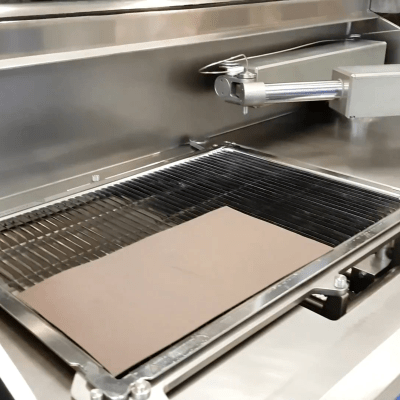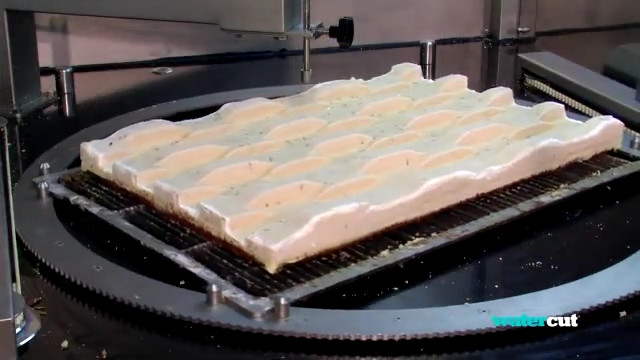We need more high-end, geometric pastry in our lives. This insight is courtesy of a fairly old video, embedded below, demonstrating an extremely clever 2D CNC mechanism that cuts out shapes on a cake pan, opening up a universe of arbitrary cake topologies.
The coolest thing about this machine for us is the drive mechanism. A huge circular gear is trapped between two toothed belts. When the two belts move together the entire thing translates, but when they move in opposite directions, it turns. It seems to be floating on a plastic platform, and because the design allows the water-jet cutting head to remain entirely fixed, only a small hole underneath is necessary, which doubtless simplifies high-pressure water delivery and collection. Rounding the machine out are cake pans make up of vertical slats, like on a laser- or plasma-cutter table, that slip into registration pins and let the water pass through.
The kinematics of this machine are a dream, or perhaps a nightmare. To cut a straight line, it does a cycloid-shaped dance of translation and turning that you simply have to see in motion. Because of this intricate path, the cake-feed speed varies along the way, so this machine won’t be perfect for all applications and relies on a thin kerf. And we can’t help thinking how dizzy the cake must get in the process.
 Indeed, the same company put out a relatively pedestrian two-arm motion cutter (another video!) that poses different kinematic problems. It’s essentially a two-arm plotter with a moving table underneath that helps increase the working area. Details are scarce, but it looks like they’re minimizing motion of the moving table, doing the high frequency small stuff with the stiff arms. Presumably someone turned the speed on the previous machine up to 11 and spun a cake off into the room, causing them to rethink the whole move-the-cake-around design.
Indeed, the same company put out a relatively pedestrian two-arm motion cutter (another video!) that poses different kinematic problems. It’s essentially a two-arm plotter with a moving table underneath that helps increase the working area. Details are scarce, but it looks like they’re minimizing motion of the moving table, doing the high frequency small stuff with the stiff arms. Presumably someone turned the speed on the previous machine up to 11 and spun a cake off into the room, causing them to rethink the whole move-the-cake-around design.
Of course, watercut pastry isn’t limited to exotic CNC mechanisms. This (third!) video demonstrates that a simple Cartesian XY bot can do the job as well.
If you think about it, using high-pressure pure water to cut foodstuffs is a win on many levels. We’d just miss out on licking the knife. Thanks [Adam G DeMuri] for the awesome comment that lead us to a new world of watercut edibles.
















Seems like it’d be even better if they could use high pressure sugar glaze.
At one time french fries and other potato shapes were cut using water knives as that meant you had no knives to keep sharp and clean. (But if I recall correctly, it was wasteful of material even though they vacuum boiled off the water and turned the remains into pringles-type chips.)
Miss licking the knife? You could drink the sump tea.
This just goes to show that cartesian series kinematics is just “old” now.
I don’t understand why we are still using expensive components like stepper motors, linear rails, linear bearings and ball screws.
Ball bearings and ball races have been around forever and are high precision, inexpensive and come in a huge variety of specialist purposes.
Linear delta printers demonstrate we can cope with parallel kinematics. Arc delta is cheaper again. Series arc is yet cheaper again.
HP inkjet printers did away with a stepper motor to drive the print head carriage and replaced it with a DC motor (brushed) and a linear optical encoder. All that expense replaced with a plastic strip and opto-interrupter.
You can use an inverted optical mouse under the platform and have closed loop control for a complex parallel kinematics machine.
It seems to me that school children are more innovative with things like egg decorators. Perhaps that is because expense is a constraint.
Linear motion is still far more rigid than any sort of rotary linkage arrangement. Comparing an XY linear serial manipulator vs a rotary (i.e. scara arm), the worst case rigidity for the linear kinematics occurs when it’s fully extended in both axes, but is that case *all* the time for the rotary linkage. Makes using it for high rigidity machines like CNC cutters harder. In cases where you’re trying to get a passably rigid machine for the lowest cost possible, you’re still probably better off getting bottom of the barrel linear motion components.
So, a couple of days later I see this, which was posted just yesterday. You might be on to something…
https://m.youtube.com/watch?v=OoYPUCgJ-0E
Who gets to eat all the edges and other offcuts?
The client… In other cake
I often wondered how this was done. Now I know! Very interesting.
This mechanism was probably thought up in an attempt to design something that was easy to clean, but failed with the big gear and timing belts on the side.
I really do not see what this has over a regular SCARA arm arangement.
With the big round gear which also moves you also need a lot of extra size around the cake.
Here is an example of a regular SCARA arm. Maybe it looks less impressive, but it also looks like a better solution.
https://www.youtube.com/watch?v=u6WAqVgJTGk
Near the end of that video, they show the water-catcher head under the cake that was tracking the head above the whole time. Very cool.
Although they had me at minute 1:45 or so with the headline “Limitless pettifours”
The need to catch the water after it leaves the cake is indeed an extra complication for the SCARA arm. With the big round gear version, the water jet can be caught with a stationary cup. It probably is done just with timing belts to keep the top and bottom arm synchronous, so no extra motors are needed. It’s quite common for SCARA arms to have several concentric pipes to transmit different axle drives through a single joint.
It’s probably needed to catch the water, as letting it spash in the tub below it will lead to splashing water which will make the underside of the cake wet.
At least this video shows that the end product isn’t wetted.
Sure looks a lot better for less exposure for cross contamination of product vs. mechanisms. And for cleanup.
This says it’s a replay to Canoe. Like the post it’s replying too said it was it was a reply to Pauvdh. I wonder where this post will end up…
2021 and a site sw can’t get comments correct.
That wasn’t so hard. Although my spelling was.
Why couldn’t my original reply appear where it said it was…
We’ll test again, as this is showing under Canoe>Canoe, but says “Reply to” blank, and see where this one ends up.
Fantastic technology
I think the kerf size is dependent on the jigglyness of the cake and how fast it changes direction.
Nope.
The speed of the water is so high that it has so much momentum that it just keeps going. The cake might as well not be there at all. And thus the kerf width is the width of the water jet itself. If you look closely, you can see there is no tendency of the top of the mushy cake getting pushed inward or deformed in any way by the water jet.
You can compare it with de-capping beer bottles with a chainsaw at full speed. It rips the lid off in such a short time that the bottle will just stay where it’s at and not move.
The only way to change it would be to use some sirupy sugar glaze on top of the cake what will flow and connect again after the water jet passed, but that’s another subject.
Maybe air, but water???
Now cut a pizza with it, like in Count Zero. :)